Last Updated on January 10, 2024 by Kittredge Cherry
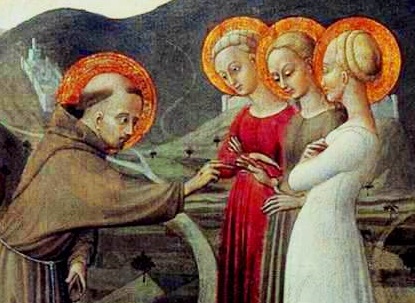
Francis of Assisi, one of the world’s best loved saints, rejoiced when an all-female Trinity greeted him as “Lady Poverty” in a queer experience that has been buried.
The subversive vision has been ignored, sanitized and perhaps suppressed for centuries, even though it is “hiding in plain sight” in the earliest source and in at least one famous altarpiece. This article is being re-posted for Trinity Sunday (June 4, 2023).
Francis is celebrated for loving animals, hugging lepers, embracing poverty and praying for peace, but few know about his gender nonconformity. The 13th-century friar’s little-known encounter disrupts and reverses traditional distinctions of gender and social class. For Francis, such earthly restrictions cannot limit God.
Christian doctrine says that there is one God in three persons: “Father, Son and Holy Spirit.” Francis saw this Holy Trinity embodied instead as “three poor women.” Does that make them Mother God, Christa and the Holy Spirit? They may be related to the the pagan “triple goddess” archetype of the maiden, mother and crone, as well as “The Three Spinners” fairy tale and the “three Norns” of Norse mythology. Church authorities sometimes allow the Holy Spirit to be represented as female, but never the entire Trinity — except this time.
Disregarding his biological sex, the women call Francis himself “Lady Poverty” — and he loves it! The genderbending name honors his commitment to upend social hierarchies and embrace poverty as a spiritual path.
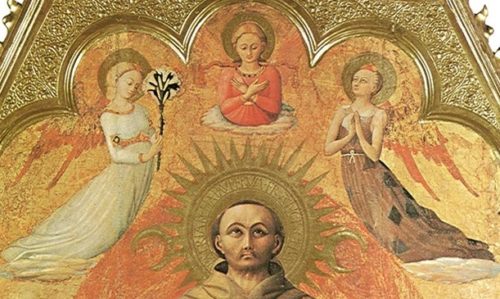
A female Trinity appears in “Saint Francis in Ecstasy” by Sassetta. (Wikipedia)
Later writers and artists downgraded the identity of the three women. Instead of embodying the Holy Trinity, they were said to represent the virtues of poverty, chastity and obedience. Lady Poverty ceased to be a name for Francis, and was recast as his bride in a mystical marriage.
Of course, all this mislabeling makes it virtually impossible for researchers to find the beautiful paintings of Francis with the female Trinity… despite the fact that art prints are widely available for both the “marriage” and the ecstasy of Francis.
Female spiritual power and queer saints become invisible. Religious authorities may have tried to disguise the story deliberately because it was seen as a threat. Or it may have disappeared by default because these ideas are almost unthinkable — too radically counter-intuitive to accept.
Why I wrote this article
My previous article about the queer side of Francis sparked questions from several serious scholars about the legend of the all-female Trinity. They wanted know the source behind my statement that Francis “experienced a vision of an all-female Trinity, who in turn saluted him as ‘Lady Poverty, a title that he welcomed.’”
A typical message said, “I love that! But I’m having trouble finding more info on his all-female Trinity on Google…”
Indeed it is extremely hard to find information online about Francis and the female Trinity. The need is clear, so I decided to write this article.
In the process I discovered a 15th-century altarpiece with a painting of the scene that, in my opinion as an art historian and religion scholar, has been misidentified all over the Internet. The painting is labeled as the mystical marriage of Francis with Lady Poverty, but a close examination shows that it illustrates the story of Francis and the female Trinity. He is not marrying Lady Poverty — he IS Lady Poverty! Later the same female Trinity floats over the ecstatic Francis in the altar’s climactic central image.
Original 13th-century account: “Three women appeared”
 The story of Francis’ encounter with the female Trinity is recorded in chapter LX of “The Remembrance of the Desire of a Soul,” one volume in the Francis trilogy. It was written within two years of Francis’ death in 1226 by Thomas of Celano, a contemporary of Francis and his earliest biographer. Here is the text, as translated by Regis Armstrong:
The story of Francis’ encounter with the female Trinity is recorded in chapter LX of “The Remembrance of the Desire of a Soul,” one volume in the Francis trilogy. It was written within two years of Francis’ death in 1226 by Thomas of Celano, a contemporary of Francis and his earliest biographer. Here is the text, as translated by Regis Armstrong:
Chapter LX: How three women appeared to him on the road, and how they disappeared after a novel greeting
I will tell in a few words something marvelous, doubtful in interpretation, most certain in truth. When Francis, the poor man of Christ, was traveling from Rieti to Siena for the treatment of his eyes, he passed through the plain near Rocca Campiglia, taking as a companion on the journey a doctor who was very devoted to the Order. Three poor women appeared by the road as Saint Francis was passing. They were so similar in stature, age, and face that you would think they were a three-part piece of matter, modeled by one form. As Saint Francis approached, they reverently bowed their heads, and hailed him with a new greeting, saying: “Welcome, Lady Poverty!” At once the saint was filled with unspeakable joy, for he had in himself nothing that he would so gladly have people hail as what these women had chosen. And since he thought at first that they really were poor women, he turned to the doctor who was accompanying him, and said: “I beg you, for God’s sake, give, something to these poor women.” The doctor immediately took out some coins, and leaping from his horse he gave some to each of them. They then went on for a short way, and suddenly the doctor and the brothers glanced back and saw no women at all on that whole plain. They were utterly amazed and counted the event as a marvel of the Lord, knowing these were not women who had flown away faster than birds.
Who are these three supernatural women? Early Franciscan writer Saint Bonaventure (1221-1274) wrote in his Life of Saint Francis that this triple goddess symbolized the three virtues of charity, obedience and poverty. His interpretation has been widely accepted.
Kevin Elphick, a scholar specializing in queer Franciscan subjects, explains in a recent article how “the language describing the three women is inescapably Trinitarian in formula.” The description of them as “a three-part piece of matter, modeled by one form,” closely resembles Christian creeds that proclaim the Trinity as three distinct persons of one substance.
He points out how the appearance of the three women also echoes the story in Genesis of how Abraham and Sarah welcomed three mysterious visitors. They are interpreted in Christian tradition as the three persons of the Holy Trinity. Elphick presents full evidence for the Trinitarian understanding in his article “Thee Poor Women Appeared” in the winter 2016 issue of “Franciscan Connections: A Spiritual Review.”
In addition, “Francis of Assisi: The Life” by Augustine Thompson (2013) flatly states, “Francis, who always sought the divine even in the humblest of places, identified the three as a manifestation of the Trinity, sent to support him in his trials.”
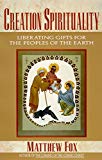 In case anyone doubts that the church would deliberately suppress imagery of a female Trinity, I can report from personal experience that this is still happening in our times. Church leaders pressured Robert Lentz, a Franciscan friar and world-renowned iconographer, to withdraw permission to use his all-female “Celtic Trinity” icon (along with some other alternative and gay-positive icons). Now his female Trinity icon is pretty much purged from the Internet, but it remains on the cover of “Creation Spirituality: Liberating Gifts for the Peoples of the Earth” by Matthew Fox.
In case anyone doubts that the church would deliberately suppress imagery of a female Trinity, I can report from personal experience that this is still happening in our times. Church leaders pressured Robert Lentz, a Franciscan friar and world-renowned iconographer, to withdraw permission to use his all-female “Celtic Trinity” icon (along with some other alternative and gay-positive icons). Now his female Trinity icon is pretty much purged from the Internet, but it remains on the cover of “Creation Spirituality: Liberating Gifts for the Peoples of the Earth” by Matthew Fox.
15th-century art shows Francis and female Trinity
Take a close look at the 15th-century painting by Italian Renaissance artist Stefano di Giovanni di Consolo, who is known as Sassetta.
Many usually reliable websites display this painting with titles such as “The Marriage of Saint Francis to Lady Poverty” or “The Mystical Marriage of Saint Francis.” Mystical, yes. But what makes them think this is a marriage? Especially a heterosexual marriage?
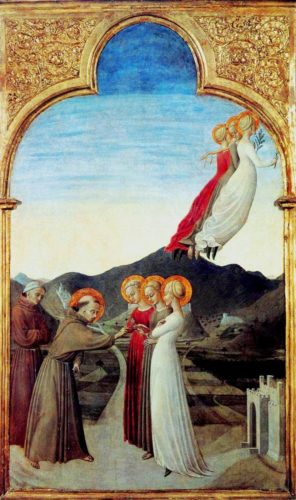
Saint Francis with Female Trinity by Sassetta… better known as “The Marriage of Saint Francis with Lady Poverty” by Sassetta. This panel is housed at Musée Condé in Chantilly, France. (Wikipedia)
If this was a wedding, why would all three women fly away to heaven afterward? And how did the identity of Lady Poverty switch from Francis himself to one of the women? The dominance of heterosexual marriage and gender conformity must have been too powerful to resist. However, the painting matches the original story much better than the marriage model.
I believe it should be titled “Three Women Appear to Saint Francis,” sticking with the language of the earliest text. If I wanted to be as bold as my predecessors in excluding alternate interpretations, I would call it “An All-Female Trinity Greets Saint Francis as Lady Poverty.”
Web Gallery of Art offers the standard interpretation:
“This panel, one of the eight smaller scenes accompanying the “Saint Francis in Ecstasy” on the back of the double-sided altarpiece, shows the saint stepping forward to place a ring on the finger of Poverty, who stands between Chastity and Obedience, as the three float off for celestial regions. Poverty glances back sweetly toward her bridegroom.”
The middle woman of the Trinity who glances back fondly at Francis could well be a female Christ figure or Christa. A close look reveals that Francis is offering the threesome a blessing, not a wedding ring.
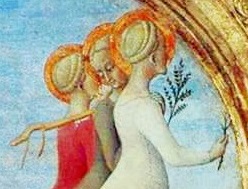
Middle woman in the female Trinity looks back at Francis in a detail from Sassetta’s alterpiece. (Wikipedia)
 Top art historians from many nations wrestle with the implications in “Sassetta: The Borgo San Sepolcro Altarpiece,” a major book edited by Machtelt Israëls and published in 2009 by Villa I Tatti, the Harvard Center for Italian Renaissance Studies. The book has been called “the most exhaustive study of a single altarpiece ever undertaken.”
Top art historians from many nations wrestle with the implications in “Sassetta: The Borgo San Sepolcro Altarpiece,” a major book edited by Machtelt Israëls and published in 2009 by Villa I Tatti, the Harvard Center for Italian Renaissance Studies. The book has been called “the most exhaustive study of a single altarpiece ever undertaken.”
The scholars describe searching in vain for traces of gilding or damage in the area where the wedding ring should be. They certainly are wedded to the belief that this is a wedding. A queer interpretation seems beyond their ability to imagine, so they express sincere befuddlement with lines such as:
“There is another extraordinary detail in the Chantilly picture… The ring is missing and its absence cannot be ascribed to subsequent damage… It is difficult to see how Francis’s and Lady Poverty’s hands could meet to exchange a ring. So what sort of marriage is this? To answer this question, we need to examine the poses and gestures of the central figures carefully…Sassetta depicted Saint Francis blessing Lady Poverty, rather than Christ blessing their union. The gesture of benediction is unmistakable… There are no known precedents for this iconography.” (pages 297-298)
Too bad they didn’t explore or even entertain the possibility that Francis was in the presence of an all-female Holy Trinity. Art historians tend to look for precedents only in other artworks, not in original text sources. However they did use Sassetta’s other image of the female Trinity as their book cover.
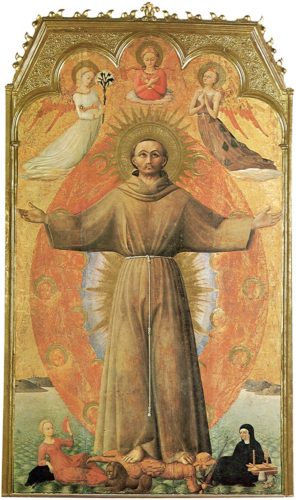
“Saint Francis in Ecstasy” by Sassetta (Wikipedia)
The same three women make an impressive appearance in the larger central image of the Sassetta altarpiece: “Saint Francis in Ecstasy” or “The Ecstasy of Saint Francis.” It is the crown jewel in the Italian art collection at Villa i Tatti near Florence, Italy.
Both unconventional panels come from the back of a huge double-sided altarpiece created for the church of the convent of San Francesco at Borgo San Sepolcro in 1437-1444. It has been called “the Rolls Royce of early Renaissance painting,” standing 20 feet high with multiple hinges and a gilded frame. Its 60 panels have been dismantled and distributed to 12 museums.
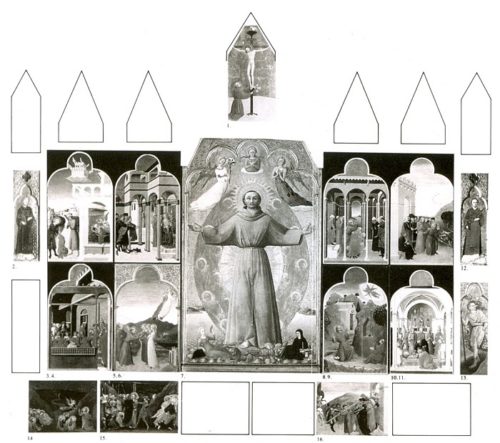
A reconstruction of the Saint Francis altarpiece by Sassetta shows how the paintings of the female Trinity were positioned (Wikipedia)
The two paintings of the female Trinity were located next to each other, so the trio seems to be flying from their first encounter with Francis toward the central climax of his ecstasy.
In the culminating scene, the Trinitarian identity of the three women seems to be reinforced by their glorious appearance and impressive golden halos. Francis extends his arms in rapture as the female Trinity hovers divinely above his head.
___
Top image credit: Detail of Saint Francis with female Trinity by Sassetta… better known as “The Marriage of Saint Francis with Lady Poverty” (Wikipedia)
___
This post is part of the LGBTQ Saints series by Kittredge Cherry. Traditional and alternative saints, people in the Bible, LGBT and queer martyrs, authors, theologians, religious leaders, artists, deities and other figures of special interest to lesbian, gay, bisexual and transgender and queer (LGBTQ) people and our allies are covered.
This article was originally published on Q Spirit in February 2019, was expanded with new material over time, and most recently updated on June 1, 2023.
Copyright © Kittredge Cherry. All rights reserved.
Qspirit.net presents the Jesus in Love Blog on LGBTQ spirituality.








Wait… I can not understand…
Does this mean that Francis felt like a woman himself or what?
Even according to this article itself, the actual document describing the incident of St. Francis meeting the three women never describes them as the Trinity, but merely as three women who seemed to disappear. The only sources you can list who interpret them as the Trinity are two modern activists. You’ve also created your own personal interpretation of an altarpiece painting which is ambiguous at best and in any event was simply a painting by one artist rather than some sort of definitive ruling on the nature of these women. You’re grasping at straws.
I agree with your comment wholeheartedly. St. Francis did not ascribe to the vision as ‘ Holy Trinity”. And some, including the author of this article, added their own interpretation and would like us to believe that what they say is true. It should also be pointed out that the book informing us about this vision was written after St. Francis’ death which means that he was no longer around to shed light on such event. I certainly hope that people should not distort what was plainly written. Thank you.
Love this article. As a franciscan and member of the Mercy of God Community, I know that Lady Poverty also included Clare of Assisi. I love the words to the current song by Dishwalla:
Tell me all your thoughts on God
‘Cause I’d really like to meet her
And ask her why we’re who we are
Tell me all your thoughts on God
‘Cause I’m on my way to see her
So tell me am I very far
Am I very far now?
Thank you so much for this post. I love the idea of a female Trinity and indeed of Francis as Lady Poverty. I’m relatively new to exploring Queer Theology and have just come across this site and am so glad I did. Truly enlightening. Thank you.
Thank you for your insight and inspiration.
San Francisco is currently deciding how Sutro Tower should change for 2020 forward and I used your article to comment on the article at sfchronicle.com to call for lighting the tower of threes like the SF Bay Bridge
A Tower of threes replacing Sutro’s original at the center
Three Cities creating the greatest metropolis since Athens
Three joints in the finger, but still only one finger pointer
Three muses to inspire release from the arrogance of influence
A Trinity of women appeared to Lady Poverty as diviner
San Francisco is a poetic paradox best expressed in light confluence
Hello. I mystical marriage marriage too place between Saint Francis and I in 2013. His prophecy of a bride has been fulfilled. I am very much a real person and not an allegory personification. I live in London. Peace.
Monira
I also want to comment upon your remark that “Church authorities sometimes allow the Holy Spirit to be represented as female, but never the entire Trinity — except this time.”
It is truly fascinating how the Church polices God’s gender….in my own experiences with Catholicism, I have heard each of the Three Persons of God described with feminine language — but never all three at once! Jesus is linked to Sophia, Woman Wisdom, or his description of himself as a Mother Hen is brought up; the Holy Spirit is the feminine /ruakh/ or breath of God brooding bird-like over the waters of Creation; God the Father/Mother/Parent/Creator is likened to a midwife or a mother in areas of the Hebrew Bible…..I’ve heard or read Catholic priests mention all of those things.
But for all Three Persons, or even just two of the three, to be feminine at once? Never!
What is that all about? Why this fear in sometimes depicting the Trinity as majority-feminine (2/3 or 3/3 instead of just 1/3 feminine at a time) rather than majority-masculine or majority-“neutral”?
Reading through this article filled me with such wonder and joy — along with frustration that this story has been misinterpreted and buried.
I agree with Elphick 100% that “a three-part piece of matter, modeled by one form” is clearly language about the Trinity. If not for that detail, perhaps I could understand scholars who interpret this account as being about Poverty, Chastity, and Obedience; but that description is so Trinitarian that only willful ignorance could keep one from noticing it. And where in the original account do they even pull a reading of it as a marriage? There is no talk of marriage, and all that is exchanged between Francis + his doctor and these three women are some words and some coins. No ring — just as you explain there is no ring Sassetta’s painting of this story.
Of course, even if the account /were/ about Poverty, Chastity, and Obedience, and about Francis being wedded to Poverty, queerness would remain: First, that a person assigned male at birth is called a “Lady;” and second, that this person called “Lady Poverty” is wedded to Poverty, a lady. If a wedding it is, then that wedding is of two who are identified as feminine, rather than a cisheteronormative masculine/feminine couple. So whatever interpretation one takes for this account, the queerness of it cannot be denied!
Finally, I want to highlight Francis’s joy upon being hailed as “Lady Poverty”: :At once the saint was filled with unspeakable joy, for he had in himself nothing that he would so gladly have people hail as what these women had chosen.” How beautiful! How like the experience of many trans people, when we are “hailed” with our chosen name and pronouns for the first time! His joy sounds a lot like gender euphoria (the positive counterpart of “gender dysphoria”) to me. Indeed, Francis’ story is queer through and through.
As far as I can tell, they fixated on the idea of marriage because Bonaventure’s version of this incident notes that during his lifetime Francis saw Poverty as his mother, his lady and his bride. They couldn’t’ seem to fathom that Poverty saw Francis as her lady too! Thanks for your great comments.
Thanks Kittredge – impressive research which I will share on Franciscan sites as I am a Franciscan tertiary.
Great! I’d love to share these insights with the wider Franciscan community. Thank you for your appreciation and sharing.